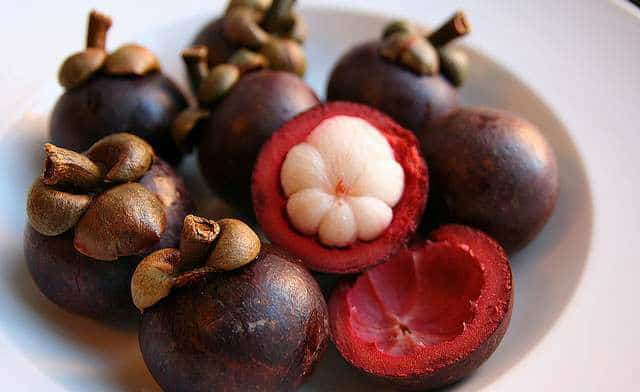The mangosteen, also known as the “queen of fruits” is a tropical fruit which originated in Southeast Asia. Its flavor is described as being “exquisitely luscious and delicious“, and because of this, mangosteen production has slowly spread throughout the world. The edible portion is the four-eight little pieces of white, juicy flesh contained within the fruit. They are usually eaten fresh as a dessert, athough some Thais use green mangosteens in a curry and it is sometimes added to fish curry in India.
To preserve the fruit, it is sometimes canned, though it loses some of its delicate flavor in the canning process. It is also sometimes made into jam. Even the rind, which contains pectin, can be made into a jelly as long as it is treated with sodium chloride to get rid of its astringent quality. The seeds are sometimes eaten as well after having been boiled or roasted. Mangosteen has other uses; tannin and rosin found in the rind are used for tanning leather in China. In Thailand, the wood is used in various types of construction.
Wild mangosteen trees were likely first domesticated in Thailand and Myanmar. The fruit-bearing tree is now heavily cultivated throughout Southeast Asia. It has slowly been introduced for domestication in other tropical climates throughout the world but not without difficulties. The tree requires high humidity and high annual rainfall with no significant periods of drought, and therefore thrives particularly well in areas like Southeast Asia. Farmers have found that not all tropical climates are ideal for growing this particularly fussy tree. It requires very specific growing conditions, including good drainage and rich organic soil that is not highly salinated. The tree cannot tolerate temperatures below 40 degrees Fahrenheit, which limits it to lower elevations. Mangosteen trees require lots of water; those grown near banks of streams, lakes, and ponds tend to be the most prolific fruit producers. The trees do not like overly windy conditions or salt spray. Mature trees often reach up to 40 feet in height and can produce up to 1,000 fruits a year.
The mangosteen is also known for having a variety of medicinal properties. It has long been used for aiding the immune system due to the presence of antioxidants such as xanthone, which potentially has anti-cancer properties. For the time being, mangosteen products have yet to be proved safe and effective cancer treatments by the U.S. Food and Drug Administration, although at least one study showed that mangosteen slowed the growth of various cancer cells in rats. Because of its potential as an alternative medicine, it has more recently been sold in various forms on the health food market in the U.S.
Various parts of the tree are used by native healers in countries where it is grown. In some countries, an ointment made from mangosteen is applied to the skin to help heal injuries and infections. In addition, the dried and powdered rind is used to treat dysentery and the roots are sometimes boiled down to make a healing tea for women dealing with menstrual problems.
For a long time, mangosteens could not be legally imported into the U.S because of the threat of introducing various pests. Regulations have changed, however, and there are now a few countries who can export them to the U.S., including Thailand, where they grow so prolifically. Mangosteens coming from Thailand and certain other countries must be irradiated to sterilize insect pests; this is controversial because it may produce carcinogenic compounds and destroy essential vitamins.
A colonial governor in Indonesia was quoted as saying that the mangosteen “is at the same time so juicy, that many people can never eat enough of it, so delicious is its fragrance and agreeable its sweetness…” This same enthusiasm continues today.













